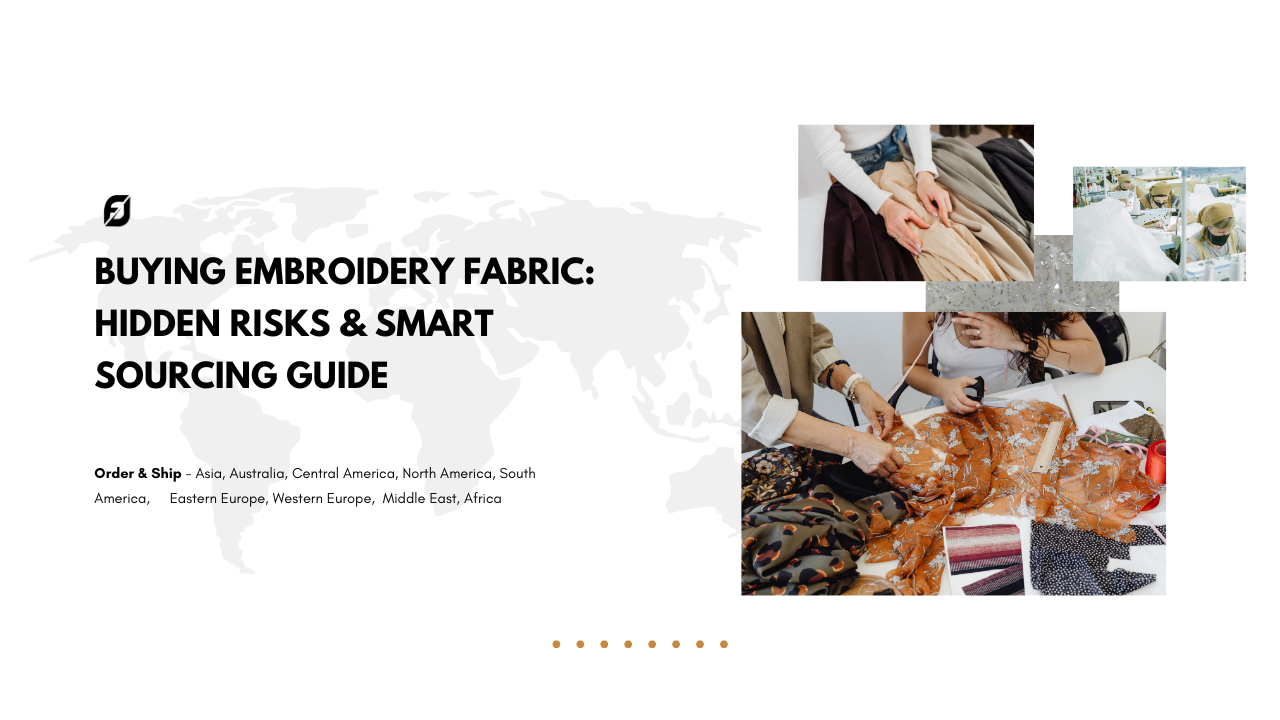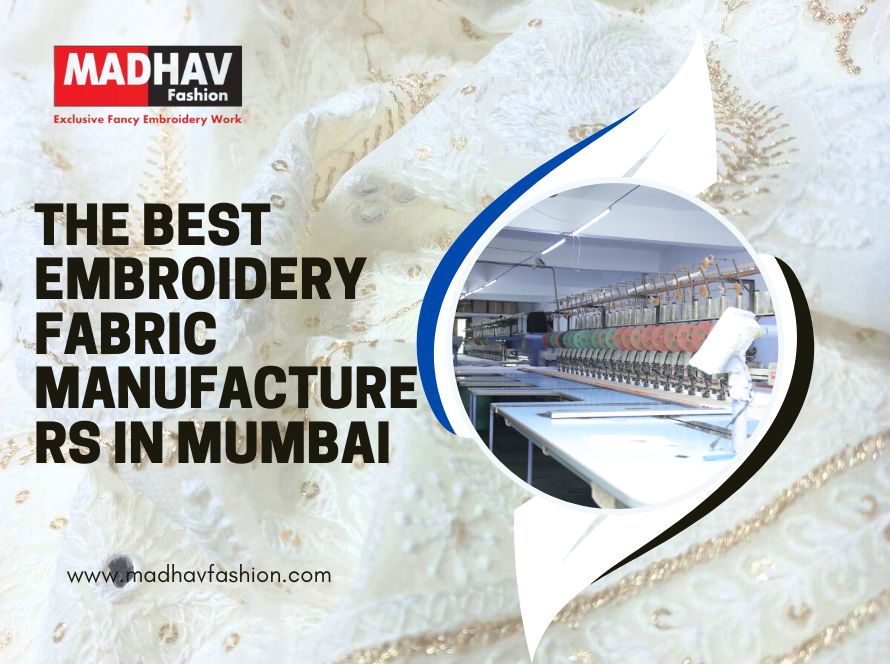Welcome to our world of exquisite embroidery fabric, where tradition meets modern fashion.
Whether you’re in Europe, Africa, the Middle East, North America, South America, Central America, or Asia, our embroidery fabrics offer unparalleled quality and style.
Discover Premium Embroidery Fabric: Tailored Solutions for Global Fashion Trends
Dive into the rich textures and vibrant designs that elevate any garment and discover why our fabrics are a top choice for fashion enthusiasts worldwide.
Embroidery Fabric: The Epitome of Elegance Our collection of embroidery fabrics features intricate patterns and high-quality materials that cater to diverse fashion needs. From delicate floral designs to bold geometric patterns, each fabric is crafted to enhance the beauty of any garment. Our fabrics are ideal for creating everything from elegant evening wear to stylish casual outfits, making them a versatile addition to your wardrobe.
Benefits of Our Embroidery Fabrics
- Exceptional Quality: We use only the finest materials to ensure durability and a luxurious feel.
- Versatile Applications: Perfect for a range of garments, including dresses, shawls, and accessories.
- Cultural Appeal: Our fabrics reflect global fashion trends, making them suitable for diverse styles and preferences across different regions.
Regional Appeal
- Europe: Embrace the sophistication of European fashion with our elegant embroidery designs that complement classic and contemporary styles.
- Africa: Celebrate vibrant patterns and rich textures that align with Africa’s diverse fashion scene and cultural heritage.
- Middle East: Enhance your garments with opulent embroidery that reflects the region’s luxurious fashion trends.
- North America & South America: Our fabrics offer a blend of modernity and tradition, catering to diverse fashion tastes and trends.
- Central America & Asia: Experience the fusion of traditional and contemporary designs, perfect for local fashion and global styles.
Explore Custom and Ready-Made Options In addition to our standard range, we offer custom embroidery services to create unique designs tailored to your specifications. Our make-to-order option ensures that you receive exactly what you envision, whether it’s a bespoke garment or a custom fabric for your fashion collection.
Call to Action Explore our extensive range of embroidery fabrics and transform your fashion creations with our premium materials. Visit our website to browse our collection, request a custom order, or contact us for more information. Elevate your style with the elegance and quality of our embroidery fabrics.
_____________________________________________________
1. What is embroidery fabric, and how is it used in fashion?
Embroidery fabric refers to textiles that feature decorative stitching patterns applied by hand or machine. These fabrics can be made from various materials, including cotton, silk, and polyester. Embroidery adds intricate designs such as florals, geometric patterns, or custom motifs, enhancing the aesthetic appeal of the fabric.
In fashion, embroidery fabric is used for creating garments such as dresses, blouses, and shawls, as well as accessories like bags and scarves. The fabric can be embroidered with different techniques, including thread work, beadwork, and sequins, to achieve a range of looks from subtle elegance to bold statements. The versatility of embroidery fabric allows designers to infuse their creations with unique textures and patterns that stand out in any fashion collection.
Benefits of using embroidery fabric include its ability to elevate simple designs into luxurious pieces and its potential for customization, which can cater to individual preferences or cultural motifs.
2. How can I choose the right printed fashion fabric for my collection?
When choosing printed fashion fabric, several factors should be considered to ensure it complements your collection. First, consider the fabric type—whether it’s cotton, silk, polyester, or a blend—based on the desired texture, drape, and durability. Each fabric type has its own characteristics and applications, so select one that aligns with your design goals.
Print quality is another crucial factor. Ensure that the prints are clear, vibrant, and accurately reflect your design vision. Check for colorfastness to prevent fading over time. Additionally, consider the season and target audience. Fabrics suitable for summer might differ from those intended for winter, and prints should resonate with your audience’s preferences and current trends.
Cost and sourcing are practical considerations. Ensure the fabric is within your budget and sourced from reputable suppliers to guarantee quality and consistency. Balancing these factors will help you select the ideal printed fabric for your fashion collection.
3. What are the benefits of using plain fabric in garment design?
Plain fabric refers to textiles that do not feature patterns or prints. The primary benefit of using plain fabric is its versatility. It serves as a blank canvas, allowing for various styles, colors, and textures to be incorporated into garment design. Plain fabrics are ideal for creating classic, timeless pieces or for serving as a base for adding embellishments such as embroidery, prints, or appliqué.
Another advantage is the ease of coordinating plain fabrics with other elements. They can be paired with patterned fabrics or accessories to create balanced and visually appealing outfits. Plain fabrics are also often more cost-effective compared to printed or embroidered options, making them a practical choice for budget-conscious projects.
Additionally, plain fabrics offer a clean, streamlined look that can be easily adapted to different fashion trends and personal styles, making them a staple in any wardrobe.
4. How does custom design work with embroidery fabrics?
Custom design with embroidery fabrics involves creating unique patterns and motifs tailored to specific preferences or requirements. The process typically begins with design consultation, where you discuss your vision, including desired patterns, colors, and techniques. This is followed by the design phase, where digital or hand-drawn prototypes are created based on your input.
Once the design is finalized, it is transferred onto the fabric using embroidery techniques such as machine embroidery, hand stitching, or a combination of both. The chosen method impacts the final look and texture of the embroidery.
Quality control is essential throughout the process to ensure that the final product meets your standards. Custom embroidery allows for a high level of personalization, making it an ideal choice for bespoke garments, branding, or unique fashion pieces.
Final steps include reviewing samples and making any necessary adjustments before completing the order. The result is a one-of-a-kind fabric that reflects your individual style or brand identity.
5. What should I consider when selecting plain fabric for custom garments?
When selecting plain fabric for custom garments, several key factors should be considered:
- Fabric Composition: Choose a fabric that aligns with the intended use of the garment. Options include cotton for casual wear, silk for formal occasions, or polyester for durability.
- Weight and Drape: The weight and drape of the fabric affect the garment’s fit and movement. Lighter fabrics are suitable for flowy designs, while heavier fabrics work well for structured garments.
- Color and Finish: Ensure the color complements your design concept and is available in the desired finish, such as matte or glossy. Fabric finish can impact the overall appearance and feel of the garment.
- Quality and Comfort: Prioritize high-quality fabrics that are comfortable and breathable. Consider factors such as texture, softness, and durability to ensure the garment is enjoyable to wear.
- Cost and Sourcing: Verify that the fabric fits within your budget and is sourced from reputable suppliers to ensure consistency and quality.
6. How can I incorporate custom designs into make-to-order garments?
Incorporating custom designs into make-to-order garments involves a systematic approach to ensure the final product aligns with your vision. Start by finalizing the design with detailed specifications, including patterns, colors, and materials. Provide these details to the manufacturer or designer responsible for creating the garment.
Next, review prototypes or samples to ensure that the custom design is accurately represented and meets your quality standards. Make any necessary adjustments before approving the final version. This step is crucial for achieving the desired look and fit.
Production involves creating the garment according to your specifications. Ensure that you communicate any special requirements or preferences, such as fabric choices or stitching details.
Finally, inspect the completed garment to confirm it matches your design. Custom designs in make-to-order garments offer a personalized touch, making them ideal for unique fashion statements or exclusive collections.
7. What are the advantages of make-to-order fashion compared to ready-made garments?
Make-to-order fashion offers several advantages over ready-made garments:
- Customization: Make-to-order allows for complete customization, including fabric choice, design details, and fit. This ensures the garment meets specific preferences and requirements.
- Unique Creations: Each make-to-order piece is unique, tailored to individual specifications. This exclusivity is ideal for clients seeking distinctive fashion items.
- Fit and Comfort: Custom garments are designed to fit the client’s measurements precisely, enhancing comfort and wearability.
- Quality Control: Make-to-order fashion often involves closer attention to detail and quality, ensuring a higher standard of craftsmanship.
- Sustainability: Make-to-order reduces overproduction and waste, contributing to more sustainable fashion practices by producing only what is needed.
Overall, make-to-order fashion provides a personalized experience, resulting in garments that are uniquely suited to the client’s tastes and needs.
8. How can printed fashion fabrics enhance my clothing line?
Printed fashion fabrics can significantly enhance your clothing line by adding visual interest and reflecting current trends. Here’s how:
- Trend Reflection: Printed fabrics allow you to incorporate popular designs and patterns, keeping your collection aligned with fashion trends.
- Brand Identity: Unique prints can help establish and communicate your brand’s identity, setting your clothing line apart from competitors.
- Design Versatility: Printed fabrics offer diverse design options, from bold graphics to subtle patterns, enabling creative and varied garment designs.
- Visual Appeal: Vibrant prints can attract attention and create eye-catching pieces that stand out in a crowded market.
- Customer Engagement: Offering a range of prints can cater to different tastes and preferences, appealing to a broader audience and driving customer interest.
Incorporating printed fashion fabrics into your collection can enhance its appeal, showcase your creativity, and effectively communicate your brand’s style.
9. What factors affect the pricing of custom embroidered fabrics?
The pricing of custom embroidered fabrics is influenced by several factors:
- Design Complexity: Intricate and detailed designs require more time and resources, increasing the cost. Simple designs are typically more affordable.
- Fabric Type: The cost of the base fabric can vary significantly based on its quality and composition. Higher-quality fabrics generally increase the overall price.
- Embroidery Techniques: Different techniques, such as hand embroidery or machine stitching, have varying costs. Machine embroidery is often less expensive than handwork.
- Order Quantity: Larger quantities may reduce the per-unit cost due to economies of scale. Small, one-off orders can be more expensive on a per-piece basis.
- Customization Level: Additional customizations, such as color matching or special finishes, can impact the price.
Overall, understanding these factors can help you budget effectively and make informed decisions about custom embroidery projects.
10. How do I ensure high-quality results with custom make-to-order garments?
To ensure high-quality results with custom make-to-order garments, follow these guidelines:
- Clear Specifications: Provide detailed and precise design specifications, including measurements, fabric choices, and design elements. The more accurate your instructions, the better the final product.
- Choose a Reputable Manufacturer: Select a manufacturer or designer with a strong track record and positive reviews. Quality assurance practices and experience are crucial for achieving the desired results.
- Review Samples: Request samples or prototypes to assess the quality and fit before final production. Make any necessary adjustments to ensure the final garment meets your expectations.
- Quality Materials: Use high-quality fabrics and materials to enhance the overall look and durability of the garment.
- Effective Communication: Maintain open communication with your manufacturer throughout the process to address any issues or concerns promptly.
By adhering to these practices, you can ensure that your
custom make-to-order garments are crafted to a high standard and meet your design vision.






